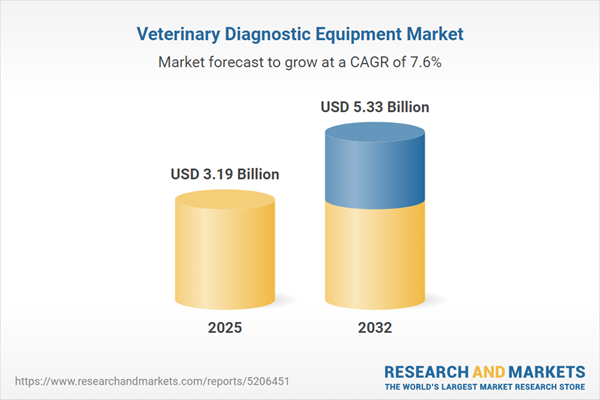Speak directly to the analyst to clarify any post sales queries you may have.
The veterinary diagnostic equipment market is evolving rapidly, driven by advanced technologies, regulatory shifts, and heightened expectations for diagnostic accuracy and service delivery. Senior executives must navigate increasing industry complexity, balancing innovation with robust compliance and operational resilience.
Market Snapshot: Global Veterinary Diagnostic Equipment Market
The global veterinary diagnostic equipment market is experiencing consistent expansion, projected to grow from USD 2.96 billion in 2024 to USD 3.19 billion in 2025 with a CAGR of 7.63%. By 2032, market value is anticipated to reach USD 5.33 billion. Growth is powered by increasing demand for cutting-edge diagnostic devices, a strategic focus on rapid and early disease detection, and heightened awareness of the risks posed by zoonotic diseases to both animals and humans. Continual regulatory updates are prompting a shift toward laboratory digitization and automation, fostering investment and opening new commercial opportunities. Enhanced digital integration improves operational flexibility and strengthens logistics, creating greater competitive advantages for market participants.
Scope & Segmentation: Veterinary Diagnostic Equipment Market Scope
This report provides a comprehensive segmentation analysis, guiding leaders in adapting procurement, risk management, and strategic planning to a dynamic veterinary health landscape. The scope connects clinical requirements with essential equipment, technologies, and stakeholder roles across the sector.
- Test Types: Biochemistry assesses metabolic health; hematology supports blood diagnostics; immunodiagnostics utilize ELISA and chemiluminescence; microbiology integrates PCR and culture methods; molecular diagnostics advance diagnostic accuracy with PCR platforms; parasitology offers microscopy and antigen screening capabilities.
- Animal Types: Solutions address needs in companion animal care, equine health, and a broad spectrum of livestock applications such as bovine, ovine, caprine, swine, and poultry. Each group faces distinct clinical and operational challenges.
- End Users: Veterinary practices, diagnostic laboratories, animal husbandry operations, research organizations, animal health pharmaceutical companies, and clinics each drive unique diagnostic demands and workflow requirements.
- Product Types: Laboratory instruments and point-of-care devices, complemented by test kits, reagents, consumables, supporting software, and maintenance contracts, are keys to robust operational delivery and reliable diagnostics.
- Technologies: The market draws on gas and liquid chromatography, immunoassay systems, PCR-based diagnostics, molecular sequencing, and IR/UV-visible spectroscopy, facilitating a broad range of veterinary applications and precision diagnostics.
- Distribution Channels: Distribution spans direct networks, specialized and regional distributors, and emerging digital marketplace platforms, each supporting supply chain strength and reach.
- Regions: Extensive coverage includes North America, South America, Europe, Asia-Pacific, Middle East, and Africa, with particular attention on China, India, and Brazil as fast-emerging market environments.
- Company Profiles: Analysis features IDEXX Laboratories, Zoetis, Heska Corporation, Thermo Fisher Scientific, Virbac SA, Neogen Corporation, Danaher Corporation, BioMérieux SA, Agilent Technologies, and QIAGEN N.V., providing insights across established leaders and innovative entrants.
A clear understanding of these segments helps executives match product portfolios and supply strategies to core clinical priorities and shifting marketplace demands.
Key Takeaways for Senior Decision-Makers
- Automation and the adoption of digital platforms are enhancing diagnostic precision and accelerating workflows, equally benefiting established operators and emerging markets.
- Integrated solutions—combining analytics, advanced instruments, and service support—are proven to build long-term provider loyalty and reinforce business partnerships.
- Point-of-care innovations provide rapid results, supporting efficient patient management in companion animal clinics, while livestock applications benefit from scalable screening and management processes.
- Market dynamics differ regionally; developed markets drive digital upgrades and Asia-Pacific stakeholders advance local manufacturing for evolving veterinary needs.
- Resilient supply chain management and proactive risk mitigation ensure operational continuity and adaptability amid shifting global regulations and increasing input costs.
- Regulation-driven digital adoption is stimulating technology investment, providing a platform for future-ready business models and greater operational oversight.
Tariff Impact: Navigating Tariffs and Policy Changes in 2025
Recent U.S. tariffs on diagnostic components and reagents have led manufacturers to diversify sourcing and reinforce domestic production capabilities. This strategic shift bolsters supply chain resilience and maintains consistent access to critical diagnostic materials, helping the industry mitigate regulatory and economic volatility.
Veterinary Diagnostic Equipment Market Methodology & Data Sources
This analysis incorporates insights from peer-reviewed publications, up-to-date regulatory frameworks, executive interviews, and comprehensive supply chain assessments. The triangulation process ensures that recommendations to decision-makers are evidence-based and provide actionable guidance for a transforming market.
Why This Report Matters
- Empowers senior executives to adjust business models and compliance practices in line with evolving regulations and market dynamics.
- Provides procurement and operations teams with intelligence for resilient supply chain management and forward-focused risk strategies.
- Supports strategic planning and investment decisions through up-to-date insights into technological advancement and legislative influence.
Conclusion
The insights in this report enable leaders to reinforce strategic agility and operational excellence, ensuring preparedness for changes ahead in veterinary diagnostics. Equip your organization to meet new clinical challenges—strengthening both compliance and market position.
Additional Product Information:
- Purchase of this report includes 1 year online access with quarterly updates.
- This report can be updated on request. Please contact our Customer Experience team using the Ask a Question widget on our website.
Table of Contents
3. Executive Summary
4. Market Overview
7. Cumulative Impact of Artificial Intelligence 2025
Companies Mentioned
The companies profiled in this Veterinary Diagnostic Equipment market report include:- IDEXX Laboratories, Inc.
- Zoetis Inc.
- Heska Corporation
- Thermo Fisher Scientific Inc.
- Virbac SA
- Neogen Corporation
- Danaher Corporation
- BioMérieux SA
- Agilent Technologies, Inc.
- QIAGEN N.V.
Table Information
| Report Attribute | Details |
|---|---|
| No. of Pages | 185 |
| Published | October 2025 |
| Forecast Period | 2025 - 2032 |
| Estimated Market Value ( USD | $ 3.19 Billion |
| Forecasted Market Value ( USD | $ 5.33 Billion |
| Compound Annual Growth Rate | 7.6% |
| Regions Covered | Global |
| No. of Companies Mentioned | 11 |









